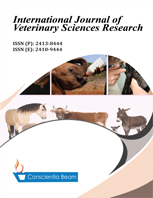Effect of Using Different Pre-Storage Warming Times on Hatchability of White Hisex Breeders’ Eggs
DOI:
https://doi.org/10.18488/journal.110/2015.1.3/110.3.54.62Abstract
It is well known that commercial hatcheries set their eggs after days of storage which increases the incubation duration, decreases hatchability, chick quality and growth performance. The objective of this experiment was to study the effect of different pre-storage warming (PRESW) times on hatchability, embryonic mortality and chick grades of White Hisex layer breeders’ eggs. A total of 1200 eggs were collected from a flock at 67 weeks of age. Eggs were divided into four groups of 300 eggs each according to their warming time (0 hour as control, 2 hours, 4 hours and 6 hours, respectively). These groups were further subdivided into four replicates. of 75 eggs each and were assigned to the completely randomized design (CRD). Eggs were incubated at 37.5°C. All eggs after warming were stored for two days in a cooler at 18°C and a relative humidity of 75%, they were then incubated in (Pas Reform) setter for 18 days and hatcher for three days. At the end of the hatching process hatched chicks were graded (1st and 2nd grade chick); pipped - hatched eggs were then removed and counted. The remaining unhatched eggs were broken to determine fertility and embryonic mortality. Results indicated that pre-storage warming of hatching eggs at 37.5oC for 4 hours significantly (P ≤ 0.01) reduced early dead embryos and total unhatched eggs. The first grade chicks were significantly (P ≤ 0.01) higher in pre-storage warming eggs. It is concluded that 4 hours PRESW improved hatchability percentage as it decreased embryonic mortality percentage, increased the number of saleable first grade chicks which by far increases profits.

